
An electric current is classified into following two basic types :
- Direct current,
- Alternating current.
Direct Current (D.C.) :
The direct current is that current which flows continuously in one direction and has constant magnitude with respect to time. Fig. 1.1 (a) shows the graph for such a current against time.
Alternating Current (A.C.) :
Each cycle consists of two half cycles. During one of these half cycles, the current flows in one direction around the circuit and during the other in opposite direction (Fig. 1.1 b). While flowing in one particular direction, the magnitude of the current also changes in some regular manner with time.
Comparison of Alternating Current and Direct Current
Table given below gives the broad comparison between alternating current and direct current.
| Parameter | Alternating Current | Direct Current |
| Definition | An alternating current is one which periodically passes through a definite cycle of changes in respect of magnitude as well as direction. | The direct current is that current which flows continuously in one direction and has constant magnitude with respect to time. |
| Raising and lowering of voltage | A.C. voltage can be raised or lowered very easily with the help of a simple static device known as transformer. | Raising or lowering of d.c. voltage is not so easy and economical. |
| Generation of power on large scale | Since it is possible to build up high-voltage, high-speed a.c. generators with very large capacities, their construction and operating costs per kilowatt are low. Hence, generation of a.c. power on large scale becomes economical. | Generation of d.c. power on large scale is not economical using d.c. generators. |
| Power transmission | Due to adoption of high voltages, a.c. transmission is always efficient and economical. | In general, d.c. transmission at low voltages is not efficient and economical. |
| Operation and maintenance of electrical motors | A.C. motors are simple in construction, cheaper and more efficient than d.c. motors and, require less maintenance. | D.C. motors are relatively costly and require more maintenance. |
Applications of Direct and Alternating Currents
In the early days, small installations supplying power mainly for lighting homes and factories were utilizing direct currents. The subsequent developments led to the extensive use of alternating currents. Now-a-days, electrical energy is almost exclusively generated, transmitted, distributed and ultimately utilized in the form of alternating current only.
Some important applications of direct and alternating currents are listed below :
Applications of Direct Currents: Traction (railways), electrolytic and other electro- chemical processes, arc lamps (used for search lights and cinema projectors), telephone and telegraph systems, charging storage batteries, modern protection systems, etc.
Applications of Alternating Currents: A.C. motors, transformers, lamps, fans, majority of domestic appliances such as TVs, refrigerators, washing machines, boilers, geysers, mixers, air conditioners and innumerable other applications.
Advantages of AC Over DC
Use of alternating current offers the following principal advantages over direct current :
- Since it is possible to build up high-voltage, high-speed a.c. generators with very large capacities, their construction and operating costs per kilowatt are low. This is not possible in case of d.c. generators.
- The a.c. voltage can be raised or lowered very easily with the help of a simple static device known as transformer. Raising and lowering of d.c. voltage is not so easy and economical.
- Due to adoption of high voltages, a.c. transmission is always efficient and economical. This is because higher the voltage, lesser is the current flowing through the transmission line conductors for the given power. Consequently, the weight of conductor material and power loss in the line itself are reduced.
- A.C. motors are simple in construction, cheaper and more efficient than d.c. motors and require less maintenance.
- A.C. can be easily converted to d.c. whenever required for some specific applications.